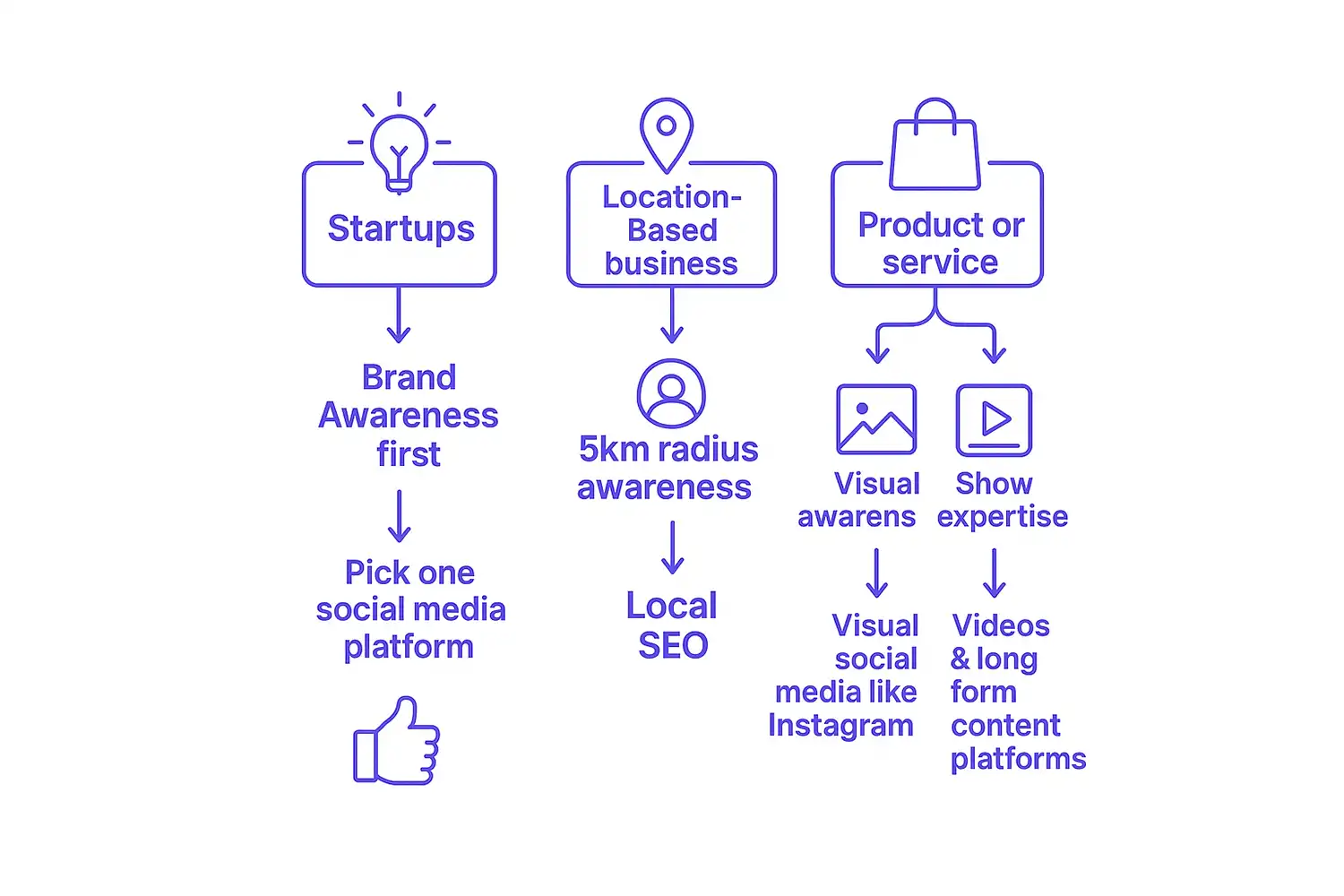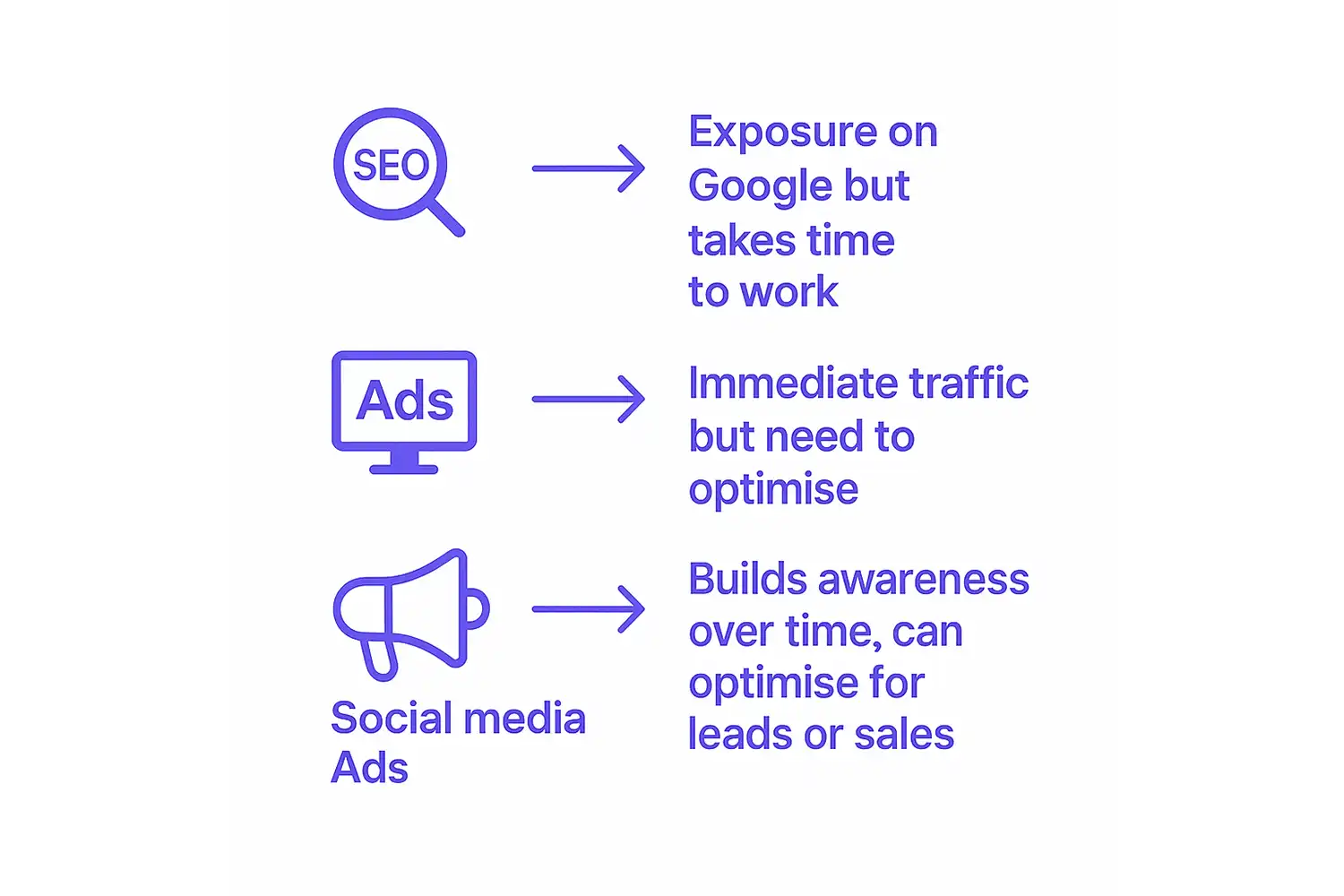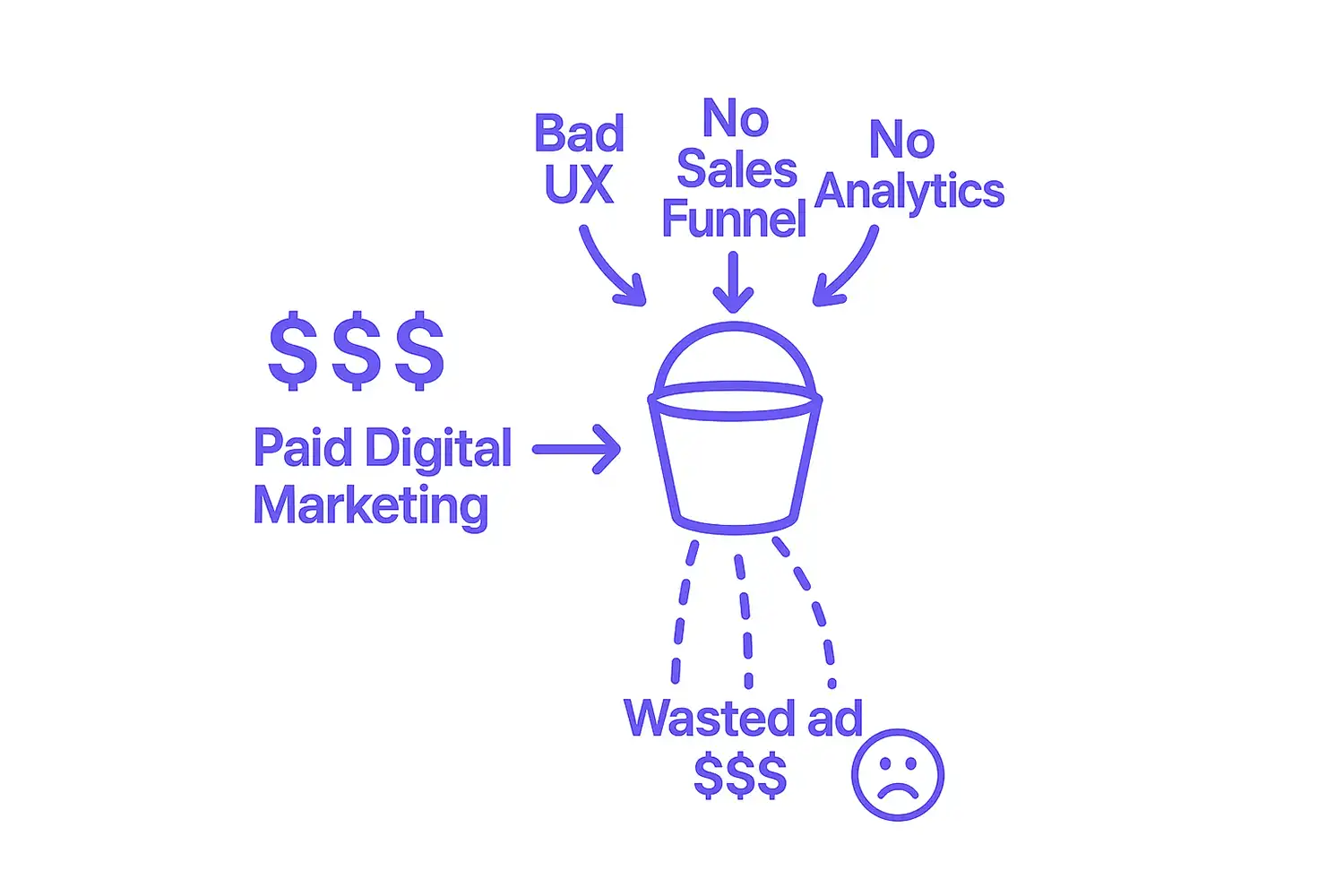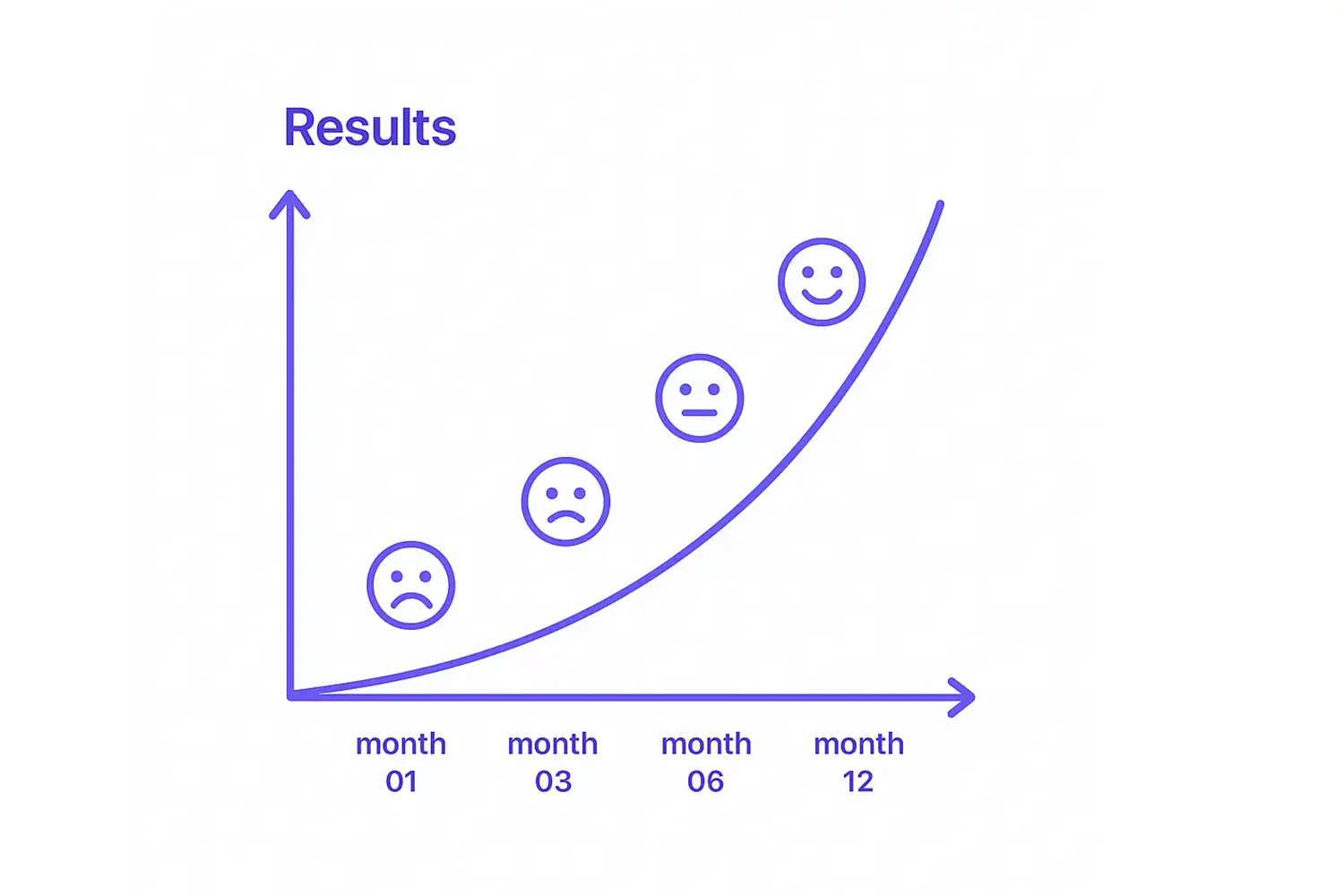Alright, let's be honest.
You know your business needs "digital marketing" - whatever the hell that actually means.
Everyone's telling you that you need to be online, you need a website, you need social media, you need Google something-or-other.
But when you start looking into it, your head starts spinning with all the jargon and acronyms. Sound familiar?
Here's the thing: digital marketing isn't some mystical dark art that only twenty-something tech wizards can understand.
It's just marketing - the same stuff you've always done to get customers.
But using online tools instead of physical ads like billboards or ads you see on buses in the city sometimes.
So what exactly is digital marketing?
Simply put, it's any way you promote your business using the internet.
That includes your website, Google searches, social media, email, online advertising.
Basically anywhere people spend time online where you can reach potential customers.
Who This Guide Is For
This guide is written for small business owners, startup founders, and anyone running a company who knows they need to do "something" online but doesn't know where to start.
You might be:
- A startup founder with a great product but no idea how to get it in front of customers
- A business owner who's tried a few things (maybe a Facebook page or Google Ads) but didn't see results
- A retail shop owner watching customers go online during COVID and not come back
- A consultant or professional service provider who knows their competitors are getting leads online
- A tradie who's been getting work through word-of-mouth but wants to expand
You don't need any technical knowledge. You don't need to understand how websites work or what all those acronyms mean.
You just need to be ready to think strategically about growing your business.
What You'll Learn (And What You Won't)
This isn't a step-by-step tutorial on how to set up Facebook ads or optimise your website for Google.
There are plenty of those gurus out there, and honestly, the technical details change all the time anyway.
Instead, this is a strategic framework for making smart decisions about digital marketing.
Think of it as your virtual CMO (Chief marketing officer) helping you figure out:
- Which types of online marketing make sense for YOUR specific business
- How to prepare your business before you spend money on marketing
- Whether you should learn to do it yourself or hire professionals
- How to avoid the common mistakes that waste time and money
- What realistic results look like and how long they take
By the end of this guide, you won't be a digital marketing expert, but you'll think like one.
You'll know how to evaluate opportunities, ask the right questions when talking to agencies, and make decisions that actually move your business forward.
Most importantly, you'll understand that digital marketing is just good business sense applied to online channels. No magic, no mystery - just smart strategic thinking.
Ready? Let's dive in mate.
1. Choosing Your Digital Marketing Strategy
All right, now that we're clear on what digital marketing actually is, let's talk about the biggest mistake most small business owners make, jumping straight into tactics without thinking about strategy.
Here's what usually happens: You see a competitor getting customers from Google, so you think "Right, I need to be on Google too!" Or someone tells you TikTok is where it's at, so you start posting videos of yourself doing silly dances.
Sound familiar?
But here's the thing - what works for your competitor might be completely wrong for your business.
Before you spend a dollar or waste a weekend trying to figure out Facebook advertising, you need to work out which approach actually makes sense for YOUR situation.
Strategy by Business Type
Not all businesses are the same, and they shouldn't all use the same marketing approach.
Let me break down what typically works best for different types of businesses.

Startups: Building Awareness When Nobody Knows You Exist
If you're just starting out, you've got two big challenges: i2
- Nobody knows who you are.
- You probably don't have a massive budget to change that quickly.
But here's the good news!
Being small can actually be an advantage if you're smart about it.
Startups need to focus like a laser beam. You can't afford to try everything at once, so don't. Pick one or two ways to reach customers and get really good at them before you even think about adding more.
Your best bet? Start with the stuff that doesn't cost money upfront but builds credibility over time. Things like:
- SEO (Search Engine Optimisation)
That's making sure people find your website when they Google things related to your business. - Creating helpful content that shows you know what you're talking about.
- Building genuine relationships with potential customers through social media or industry groups.
These approaches take time to work, but they're perfect when you can trade your time for money you don't have yet.
Location-Based Businesses: Owning Your Local Patch
If you run a local business, like a cafe, dental practice, plumbing business, or retail shop, your marketing strategy should be completely different from a startup trying to reach customers everywhere.
Local Business Reality:
- You don't need to conquer Australia
- You actually don’t need to reach whole your state or city
- You need to dominate your local area
- Geography is your competitive advantage
Local SEO becomes your best friend:
- When someone searches "dentist near me" or "best coffee in Richmond," you want to show up first
- Set up and optimise your Google Business Profile (the business listing that shows up on Google Maps)
- Get genuine reviews from happy customers
- Make sure your business details are consistent everywhere online
Here's something most local businesses miss:
you can actually compete with big national chains because geography is on your side. Sure, they might have bigger budgets, but they don't know your local community like you do.
Service vs. Product Businesses: Completely Different Games
Whether you're selling services or products makes a huge difference to your marketing approach.
Service Businesses (consulting, trades, professional advice):
- You're selling trust and expertise
- People need to believe you can solve their problem before they'll pay you
- Focus on demonstrating competence and building confidence
Best tactics for service businesses:
- Case studies showing how you've helped other customers
- Testimonials from happy clients
- Content that demonstrates your expertise (blog posts, videos, guides)
- Professional networks like LinkedIn
Product Businesses:
- You can be more visual and immediate
- People can see, touch, or experience your product
- Faster conversion potential but need higher volume
Best tactics for product businesses:
- Visual platforms like Instagram or Facebook
- Product demonstrations and user-generated content
- Reviews and social proof
- E-commerce optimization
Key difference:
Service businesses usually have longer sales cycles, meaning people take time to decide who to trust.
Product businesses can sometimes convert customers faster but often need to reach more people to make the same revenue.
Resource Reality Check: Time vs. Money
Here's the uncomfortable truth that nobody talks about, you can't bloody have everything, and trying to do everything usually means you do nothing particularly well.
You've essentially got two resources to work with, and that is your time and your money.
Most small businesses are short on both, so you need to be really smart about how you use them.

When You Have More Time Than Money
Focus on high-effort, low-cost strategies:
- SEO - optimising your website so people find it through Google searches
- Content marketing - creating helpful blog posts, videos, or guides that attract potential customers
- Social media - building relationships and showcasing your expertise where your customers hang out
- Email marketing - staying in touch with potential and existing customers
Reality check:
- These won't cost much money, but they'll absolutely eat up your time
- You need patience, might not see results for months
- Perfect for trading time for money you don't have
When You Have More Money Than Time
Focus on paid strategies that deliver faster results:
- Google Ads - paying to appear at the top of Google search results
- Social media advertising - paying Facebook, Instagram, or LinkedIn to show your content to specific audiences
- Hiring professionals - paying agencies or freelancers to handle the technical stuff
Reality check:
- You'll get results faster, but you'll pay for that speed
- You still need to understand what you're paying for
- Risk of wasting money on the wrong things if you're not strategic or the agency you are dealing with is not. (Err, let’s not start on this!)
Setting Realistic Expectations (The Bit Nobody Wants to Hear)
Digital marketing isn't magic.
Anyone who promises overnight success or guaranteed results is probably trying to sell you something.
Digital marketing is more like getting fit.
It takes consistent effort over time, and anyone promising you a six-pack in a week is talking rubbish.
Here's what realistic timelines look like:
- SEO: 6-12 months to show meaningful results
- Paid advertising: Can work within weeks, but needs time to test and optimise
- Content marketing: Builds momentum slowly but can be incredibly powerful once it gets going
- Social media: Relationship-building happens over months, not days
Remember, your competitors are probably doing this stuff too.
You're not JUST trying to get results, you're trying to get better results than they are.
That takes time, effort, and usually a bit of trial and error.
The key is to start with realistic expectations and measure your progress, not just your results.
Now that we know what we are dealing with, let’s discuss some of the tools we can use.
2. The Digital Marketing Toolkit That Works
Right, now that you've got a strategy sorted.
Let's talk about the actual tools and tactics you can use.
Think of this as your marketing toolbox.
You don't need every tool, but you should understand what each one does and when to use it.

SEO Fundamentals: Getting Found on Google
SEO (Search Engine Optimization) is basically making sure your website shows up when people Google things related to your business.
It's one of the most powerful ways to get customers because they're actively looking for what you offer.
Local SEO Essentials for Australian Businesses
If you're a local business, this should be your number one priority:
Google Business Profile setup:
- Claim and verify your business listing
- Add accurate business hours, phone number, and address
- Upload quality photos of your business
- Choose the right business categories
Review management:
- Ask happy customers to leave reviews (but don't buy fake ones - Google will penalise you)
- Respond to all reviews, especially negative ones
- Use reviews as feedback to improve your business (duh?)
Local citations:
- Make sure your business name, address, and phone number are consistent across all online directories
- Get listed in relevant Australian business directories. There are a bunch of tools for this. I use a tool called brightlocal
- Local newspapers and community websites can be goldmines for citations
Low-Competition Keyword Targeting
If you don’t know already, a keyword is simply a phrase a user might put in the Google search box to find something. For example: winter socks, tax accountant near me, how to get a girlfriend etc.
Here's a secret most Aussie small businesses don’t know.
You don't need to compete with the big players on popular keywords. Instead, focus on specific, less competitive terms that your ideal customers actually search for.
Examples:
- Instead of "plumber" → "emergency plumber Bondi Beach"
- Instead of "accountant" → "small business tax accountant Sydney"
- Instead of "dentist" → "family dentist bulk billing Melbourne"
These longer, more specific searches (called long-tail keywords) have less competition and often convert better because people know exactly what they want.
If you are curious how to find these keywords, again there are a bunch of tools for it. Just do a quick Google or ask ChatGPT for it. Most agencies use a tool called ahref or semrush
Google Ads Strategy: When Paid Search Makes Sense
Google Ads is paying to appear at the top of Google search results. It can work faster than SEO, but you need to be smart about it.
When Google Ads Makes Sense for Your Business
Good fit for Google Ads:
- You have a clear understanding of your customer lifetime value
- Your service/product has good profit margins
- People actively search for what you offer
- You have budget to test and optimise (at least $1,000-$2,000 per month to start)
Not a good fit:
- Your product/service is very low-margin
- People don't typically Google for what you offer
- You can't afford to lose money while testing
Local Targeting and Budget Considerations
For Australian small businesses, geographic targeting is crucial:
Smart targeting strategies:
- Start with a small radius around your business (5-10km)
- Exclude areas you don't service, obviously!
- Adjust bids based on location performance
- Use location-specific ad copy ("Serving Melbourne's inner suburbs")
Budget reality:
- Most industries in major Australian cities cost about $5-50+ per click
- You'll need at least 50-100 clicks to get meaningful data
- Expect 2-4 weeks to optimise campaigns properly
Social Media & Other Channels
Meta Advertising (Facebook & Instagram)
Meta advertising works differently from Google Ads. Instead of targeting people actively searching, you're interrupting them by shovelling your ad on their face, while they're scrolling.
When Meta advertising works well:
- Visual products or services
- Targeting specific demographics or interests
- Building brand awareness
- Retargeting website visitors
Australian targeting tips:
- Use detailed demographic targeting (age, location, interests)
- Test different audience sizes (Facebook recommends 1-2 million people)
- Focus on video content - it performs better than static images
- Include clear calls-to-action like buy now or learn more
Free Tactics That Actually Work
Before you spend money on advertising, nail these free strategies:
Google Business Profile optimisation:
- Post updates regularly (weekly is ideal)
- Share photos of your work, team, and customers
- Use the Q&A feature to answer common questions
- Enable messaging for direct customer contact
Customer reviews and reputation management:
- Create a simple process for asking satisfied customers for reviews
- Respond to reviews professionally and promptly
- Use negative feedback as an opportunity to show excellent customer service
- Display positive reviews on your website and marketing materials
User-generated content and testimonials:
- Encourage customers to share photos using your product/service
- Create a branded hashtag for your business
- Share customer success stories (with permission)
- Run simple contests or challenges to encourage engagement
-
3. Foundation First: Preparing for Success
Here's where most businesses stuff up.
They start spending money on marketing before their business is ready to generate the results.
It's like trying to fill a bucket with holes in it.
Before you spend a cent on advertising, you need to make sure your business foundation is solid.

Pre-Marketing Essentials
Website User Experience Optimisation
Your website is often the first impression potential customers get of your business. If it's confusing, slow, or looks like it was built in 2005, you're wasting your marketing money.
Don’t get me wrong. I don’t want your website to look “amazing”. It needs to function as expected by your target audience.
Essential website elements:
- Mobile-friendly design - more than 60% of Australians browse on mobile
- Fast loading speed - if it takes more than 3 seconds to load, people leave
- Clear value proposition - visitors should understand what you do within 5 seconds
- Easy contact information - phone number and address prominently displayed
- Professional appearance - doesn't need to be fancy, but it needs to look trustworthy
Simple fixes that make a big difference:
- Compress images to improve loading speed
- Add customer testimonials to build trust
- Include clear calls-to-action on every page ("Call now," "Get a quote," "Book online")
- Make sure your contact forms actually work (test them!)
Sales Funnel Mapping
A sales funnel is just a fancy way of describing the journey people take from first hearing about your business to becoming paying customers.
Basic sales funnel stages:
- Awareness - They discover your business exists
- Interest - They want to know more about what you offer
- Consideration - They're comparing you to competitors
- Decision - They choose to buy from you
- Retention - They become repeat customers and refer others
Map your customer journey:
- How do people currently find out about your business?
- What questions do they ask before buying?
- What makes them choose you over competitors?
- How long does the decision process typically take?
- What happens after they become customers?
Understanding this journey helps you create marketing that meets people where they are, rather than just shouting about how great you are.
Analytics Setup Basics
You can't improve what you don't measure. Setting up basic tracking lets you see what's working and what's not.
This can get pretty technical.
Then again, there are plenty of resources online. Obviously you can get ChatGPT to help you on this but with all the help in the world, even big digital marketing agencies get these things wrong.
Essential tracking setup:
- Google Analytics - free tool that shows website traffic and user behavior
- Google Tag Manager - helps you track specific actions (form submissions, phone calls, downloads)
- Conversion tracking - measure actual business results, not just website visits
Key metrics that matter for small businesses:
- How many website visitors become leads or customers
- Which marketing channels bring the highest quality leads
- Cost per customer acquisition by channel (Paid ads vs SEO or organic traffic)
- Customer lifetime value
Don't get overwhelmed by all the data. Start with tracking just a few key metrics that directly relate to your business goals.
Competitive Analysis and Positioning
Understanding your competition helps you find opportunities and avoid costly mistakes.
Simple competitive research:
- Google the main keywords related to your business
- Look at who's advertising and who ranks organically
- Check their websites, pricing, and customer reviews
- Follow their social media to see what content they share
- Sign up for their newsletters or request quotes
Find your competitive advantage:
- What do you do differently or better?
- What gaps exist in the market that you could fill?
- Where are competitors weak that you could be strong?
- What do their negative reviews complain about that you could address?
Strategic Positioning for Small Players
As a small business, you can't outspend the big players, but you can outsmart them.
Finding Your Niche in the Australian Market
Strategies for competing with larger businesses:
- Geographic specialisation - become the go-to expert in your local area
- Industry specialisation - focus on serving one type of customer extremely well
- Service specialisation - be the best at one specific thing rather than okay at everything
- Value positioning - compete on value, not just price
Examples of successful niche positioning:
- Instead of "general accountant" → "Tax specialist for tradies"
- Instead of "finance company" → "finance for solo entrepreneurs"
- Instead of "cafe" → "Specialty coffee and co-working space for freelancers"
Budget Allocation Across Channels
Don't spread your budget too thin. It's better to dominate one channel than to be mediocre across multiple channels.
Recommended budget allocation for most small businesses:
- 70% on your primary channel (usually SEO or Google Ads for service businesses)
- 20% on your secondary channel (social media or content marketing)
- 10% for testing new opportunities
Start with one channel, then expand:
- Master one marketing channel before adding others
- Once you're getting consistent results, consider adding a second channel
- Only add a third channel once the first two are running smoothly
This approach prevents you from spreading yourself too thin and gives you the best chance of actually seeing results from your marketing efforts.
4. DIY vs. Professional Services
One of the biggest decisions you'll face is whether to handle digital marketing yourself or hire professionals. There's no right answer for everyone, but there are some guidelines that can help you decide.
The Investment Decision: When to Do What
The Case for Doing It Yourself
When DIY makes sense:
- You're just starting out and have more time than money
- Your business is relatively simple (local service with clear target market)
- You enjoy learning new skills and have the patience for trial and error
- You want to understand marketing to better evaluate agencies later
Advantages of the DIY approach:
- Cost savings - obvious benefit, especially in the early days
- Deep understanding - you'll know your marketing inside and out
- Control - you can make changes immediately without waiting for someone else
- Authenticity - no one knows your business better than you do
What you can realistically handle yourself:
- Basic website updates and content creation
- Social media posting and engagement
- Google Business Profile management
- Simple email marketing campaigns
- Basic SEO tasks like keyword research and content optimisation
When to Bring in the Professionals
When professional help makes sense:
- You're profitable and marketing budget isn't your biggest constraint
- You've tried DIY for 6+ months without seeing results
- Your time is better spent running your business than learning marketing
- You need technical skills you don't have (web development, advanced advertising)
What typically requires professional help:
- Complex Google Ads campaigns - easy to waste money if you don't know what you're doing
- Website development - unless you enjoy coding, hire someone
- Advanced SEO technical work - site structure, page speed optimisation, etc.
- Marketing automation - setting up complex email sequences and tracking
Hybrid Approaches That Work
Often the best approach is a combination of DIY and professional help.
Smart hybrid strategies:
- You handle strategy and content, professionals handle technical implementation
- Hire specialists for setup, then manage day-to-day yourself
- Outsource time-consuming tasks (content writing, graphic design) while keeping strategy in-house
- Bring in consultants for quarterly strategy reviews rather than full management
Example hybrid approach for a local service business:
- DIY: Content creation, social media, customer review management
- Professional: Website development, Google Ads setup and optimisation
- Consultant: Quarterly strategy review and performance analysis
Setting Realistic Timelines and Expectations
Why Patience is Crucial in Digital Marketing
Most small business owners expect results too quickly and change tactics before they've had time to work. I've seen this way too often in my 20+ years in the digital marketing game.

Common timeline mistakes:
- Trying Google Ads for 2 weeks and deciding it doesn't work
- Publishing 3 blog posts and wondering why SEO isn't working
- Posting on social media for a month and giving up because you don't have thousands of followers
The reality of digital marketing timelines:
- Paid advertising: 4-8 weeks to properly optimise and see true performance
- SEO: 6-12 months to see significant organic traffic growth
- Content marketing: 3-6 months to build momentum and audience
- Social media organic growth: 6-12 months to build meaningful following
Avoiding the "Quick Change" Trap
Signs you're changing tactics too quickly:
- You switch strategies every month
- You haven't given any approach at least 3 months to work
- You're constantly chasing the "next big thing" in marketing
- You measure success daily rather than monthly or quarterly
How to stay the course:
- Set clear success metrics before you start
- Commit to testing each approach for a minimum timeframe
- Focus on leading indicators (website traffic, leads generated) rather than just sales
- Remember that your competitors aren't starting from zero - it takes time to catch up
Budgeting and ROI Expectations
How to Justify Marketing Spend to Stakeholders
Whether you're convincing yourself, a business partner, or investors, you need to think about marketing as an investment, not an expense.
Calculate your customer lifetime value:
- Average transaction value × number of transactions per year × number of years they remain a customer
- Example: $500 average job × 2 jobs per year × 5 years = $5,000 lifetime value
Determine acceptable customer acquisition cost:
- Generally, you can afford to spend 10-20% of customer lifetime value to acquire a new customer
- Using the example above: $500-$1,000 to acquire a customer worth $5,000
Set realistic ROI expectations by channel:
- Google Ads: 3:1 to 5:1 return on ad spend (for every $1 spent, $3-$5 in revenue)
- SEO: Can deliver 10:1+ returns long-term, but takes 6-12 months to see results
- Social media advertising: 2:1 to 4:1 return, depending on industry and audience
Realistic ROI Expectations by Channel
Year 1 expectations for most small businesses:
- Months 1-3: Investment phase - you'll spend more than you make
- Months 4-6: Break-even phase - marketing starts paying for itself
- Months 7-12: Growth phase - positive ROI and scaling successful campaigns
Warning signs of unrealistic expectations:
- Expecting 10:1 returns in the first month
- Assuming every marketing dollar will immediately turn into sales
- Not accounting for the time and learning curve required
- Comparing your results to established businesses with years of optimisation
5. Australian Market Considerations
Australia has some unique characteristics that affect how digital marketing works here. Understanding these can give you an edge over competitors who use generic international strategies.
Local Market Nuances
Understanding Australian Consumer Behavior
Australians have distinct preferences when it comes to how they want to be marketed to:
Cultural preferences:
- Authenticity over polish - Aussies can spot fake marketing from a mile away
- Straight-talking communication - we prefer honest, direct messaging over corporate speak
- Local community focus - supporting local businesses is important to many consumers
- Skepticism of hard sales tactics - relationship-building works better than aggressive sales pitches
Online behavior patterns:
- High mobile usage - ensure all your marketing is mobile-optimised
- Social media preferences - This can obviously change based on your business and target market. Ask ChatGPT.
- Search habits - Australians often include location in their searches ("near me," city names)
- Review reliance - we heavily research before buying, especially for services
Seasonal Considerations and Timing
Australia's seasons and holidays affect when people buy and how they search online:
Seasonal marketing opportunities:
- January-February: New Year motivation, back-to-school, summer holidays ending
- March-May: Autumn projects, financial year-end preparation
- June-August: Winter services, tax season, mid-year planning
- September-November: Spring cleaning, Christmas preparation, end-of-year push
School holiday impacts:
- Family businesses need to account for 4 major school holiday periods
- B2B services often slow down during school holidays as decision-makers take time off
- Local businesses may see increased foot traffic during holidays
Compliance and Privacy Considerations
Australian Privacy Laws and Data Collection
The Privacy Act affects how you can collect and use customer data:
Key requirements:
- Clear consent for email marketing - no pre-ticked boxes
- Easy unsubscribe options in all marketing emails
- Data security requirements for storing customer information
- Transparency about how you use customer data
Practical implications:
- Use double opt-in for email lists
- Include privacy policies on your website
- Be careful with remarketing pixels and tracking
- Store customer data securely
Advertising Standards and Guidelines
The Australian Competition and Consumer Commission (ACCC) regulates advertising:
What you need to know:
- Claims must be substantiated - don't make promises you can't prove
- Clear pricing - include GST and any additional fees upfront
- Honest testimonials - reviews and testimonials must be genuine
- Disclosure requirements - sponsored content must be clearly marked
Common mistakes to avoid:
- Using fake reviews or testimonials
- Making misleading claims about results or guarantees
- Not disclosing sponsored social media posts
- Unclear or hidden pricing
Conclusion: Your Digital Marketing Action Plan
Alright, we've covered a lot of ground. Phew!
Let's bring it all together with a practical action plan you can actually implement.
Key Takeaways for Immediate Implementation
Start with strategy, not tactics:
- Understand your business type and choose appropriate channels
- Know whether you have more time or money to invest
- Set realistic expectations for timelines and results
Foundation first:
- Ensure your website provides a good user experience
- Set up basic analytics tracking
- Understand your sales funnel and customer journey
- Research your competition and find your unique positioning
Choose your approach:
- Start with one primary marketing channel and master it
- Decide whether to DIY, hire professionals, or use a hybrid approach
- Allocate budget appropriately and give strategies time to work
Common Pitfalls to Avoid
Don't make these mistakes:
- Trying to be everywhere at once instead of focusing on what works
- Changing strategies too quickly before they have time to work
- Focusing on vanity metrics (likes, followers) instead of business results
- Copying competitors without understanding why their strategies work for them
- Expecting overnight results from long-term strategies like SEO
Remember:
- Digital marketing is just good business applied to online channels
- Your competitors are doing this too so consistency and patience win
- It's better to be excellent at one thing than mediocre at everything
- Measure progress, not just results
- Authenticity and value creation always beat flashy tactics
Final Thoughts
Digital marketing isn't complicated, but it does require strategic thinking and patience. The businesses that succeed online are usually the ones that understand their customers, choose appropriate strategies, and stick with them long enough to see results.
You don't need to be a tech genius or marketing guru to grow your business online. You just need to be strategic, authentic, and persistent.
Start with one channel, master it, then expand. Focus on providing genuine value to your customers rather than just promoting your business. And remember - digital marketing is a marathon, not a sprint.
Good luck, and if you need help figuring out the right strategy for your specific business, give us a yell.


